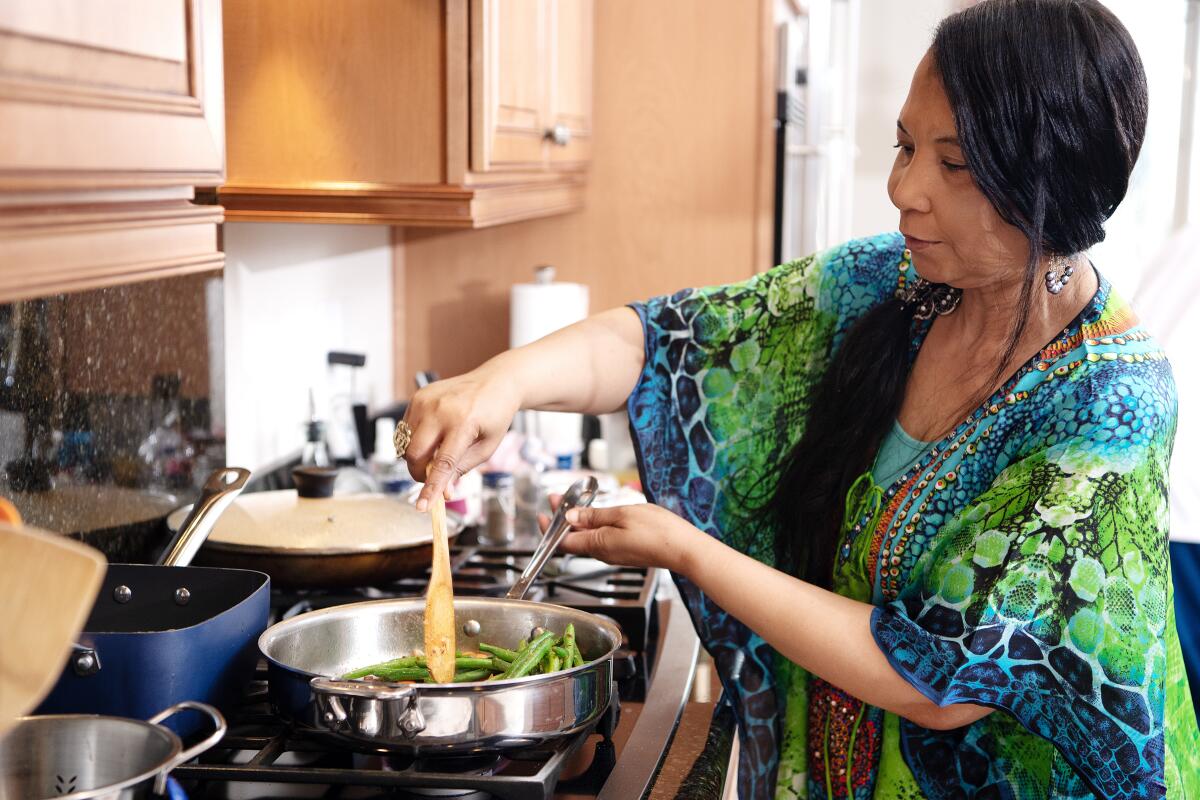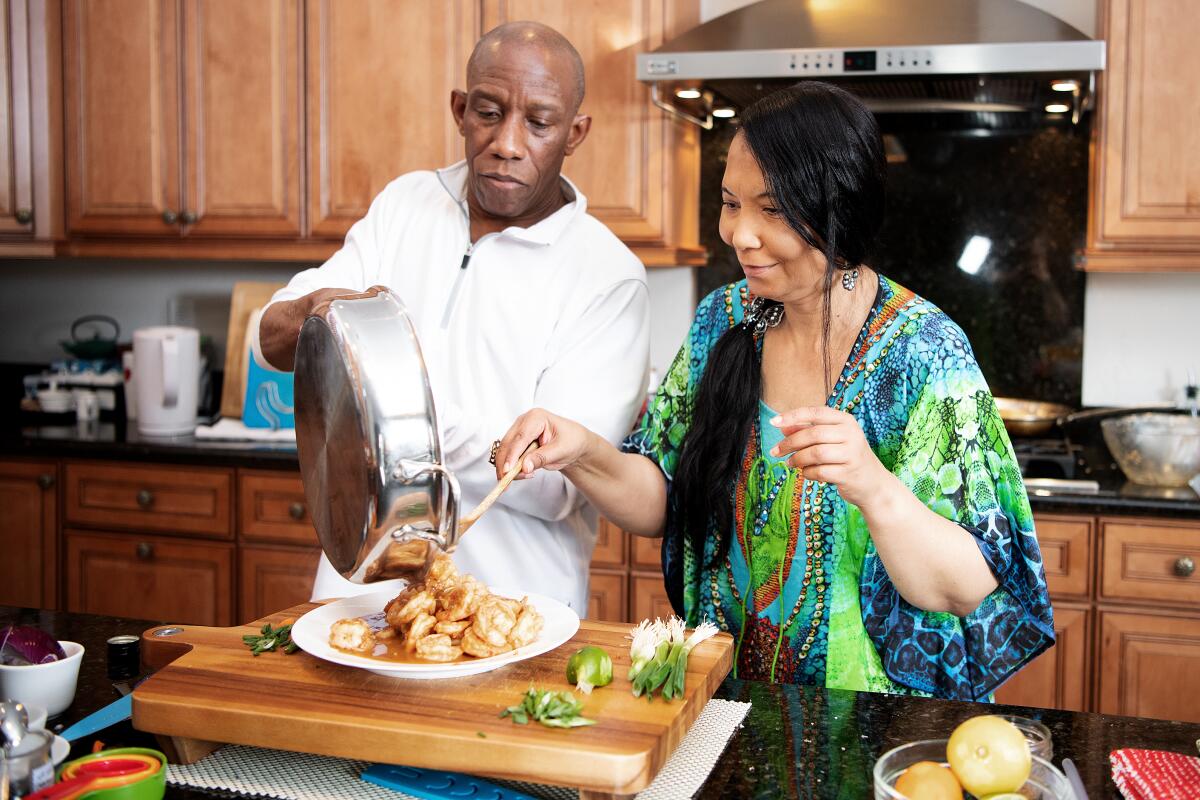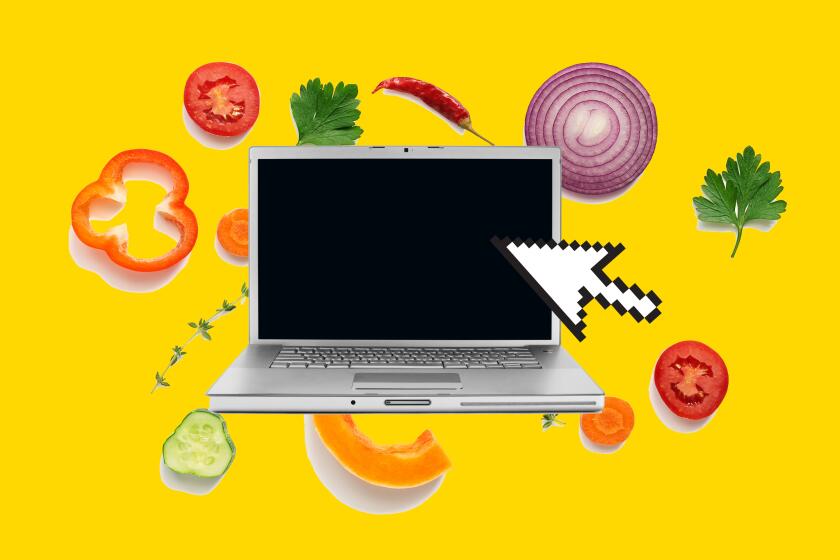Chefs and cooks in the disability community share recipes for accessibility

- Share via
Chef Regina Mitchell’s Zoom cooking class begins like a lot of Zooms: friendly banter, reminders to mute here, some technical adjustments there. A few minutes after the 4:30 p.m. start time, there are about 20 people on the call. The menu for tonight: a vegetable stir-fry and a lemongrass-ginger soda.
“The blind can cook!” she says to the camera and laughs. “People say when you have lemons, you make lemonade. I turn lemons into limoncello. Or a lemon pavlova.”
Mitchell, 60, became blind as an adult. She teaches cooking through the Nevada-based organization Blindconnect and its life skills-based program, Angela’s House. On the first and second Wednesdays of the month from her kitchen in the Las Vegas Valley, Mitchell emphasizes fun and skill-sharing to help visually impaired people feel comfortable in the kitchen.
Food and cooking are essential areas where those with disabilities can often be invisible or overlooked. But Mitchell and other advocates are working hard to address the problem by offering classes and resources and putting forth ideas to make cooking and recipes accessible.
Soon, the class begins in earnest. Much of the process is what you might expect — verbal instruction, chopping, peeling, simmering — but Mitchell emphasizes kitchen safety and exploration through touch and smell.
“I encourage you to feel the difference between corn starch, flour, confectioner’s sugar,” she says. At another point, while peeling a piece of ginger with a spoon, she reminds students, “Feel it before you peel it,” to better acquaint them with the rough-skinned root. She suggests students rub spices together in their hands to “wake them up,” which also makes them easier to identify.
Mitchell’s journey to teaching grew from necessity. “It’s a place to come; it’s a place to connect,” she says of her Zoom classes. “It’s a place to gather; it’s a place to be able to say hi. Because really, as blind individuals, we are already isolated.”
Growing up in Compton, Mitchell learned a love of food and cooking from her mother and grandmothers. Thrust into a caretaker role as a teenager after the death of a sibling, Mitchell relied on a couple of go-to dishes to feed her family: enchiladas and tacos.
After she and her future husband, Stan, met at church, the couple moved to Seattle where Mitchell enrolled at the Seattle Culinary Academy. After cooking and consulting for years as a professional chef, which included brief internships with Emeril Lagasse and Julia Child, Mitchell moved to Las Vegas for a job.
In 2011, she began to feel pain — eye pain. At the hotel where she was working, she began to notice a change. Her walking became unsteady; she felt off-balance. “I realized I didn’t have that gait like I used to have,” she says. Her colleagues noticed. “I had to ask people at work to help me read some things, undercover, of course.” Over the next several months, her vision deteriorated.
She was eventually diagnosed with bilateral panuveitis, a condition that affects the middle layer of the eye and robbed Mitchell of her sight. Her doctor wouldn’t let her return to work.
“I lost my vision, I lost my job. What do I do?” Mitchell remembers thinking. At the time, she was 50.

In the United States, 26% of adults, or 61 million people, live with some type of disability. Of those, 6.8% have an independent-living disability — something that would cause difficulty running errands alone; 5.9% are deaf or severely hearing impaired and 4.6% are blind or severely visually impaired.
Studies have shown that food insecurity, or lack of reliable access to nutritious food, is more likely to occur in households where there is someone with a disability, further demonstrating the need for accessible classes, websites and tailored teaching strategies. A study from the USDA’s Economic Research Survey estimated that 38% of households with low food security included an adult with a disability. Poor diet, the study noted, can exacerbate health conditions and disabilities.
“Who, above anyone, could use information on how to cook?” says George Stern, a deafblind writer and disability rights advocate living in Lubbock, Texas. The disabled “benefit as much as anyone from that knowledge, if not more,” he said. But to reap those benefits, companies and businesses must make access for all a priority.
Stern says we must stop thinking about providing accessibility as a burden or barrier — because it’s not. “Accessibility goes past the needs of any one disability class. An accommodation that benefits deafblind people benefits sighted people. Accommodations that benefit people in wheelchairs benefit non-disabled people.”
He cited the installation of accessible ramps in front of businesses as an example. Initially, some may complain about the cost or inconvenience, “but then you see the benefits,” for all people: parents with strollers or people making deliveries.
Kitchens and culinary spaces also should be designed with access in mind — not retroactively making accommodations. “Universal design is welcoming from the get-go,” Stern says. “We’re assuming disabled people exist because yes, hello, we do.”
The food industry, from kitchens to restaurants to culinary training spaces, still feels “off-limits” to those with disabilities, Stern says. He recalled applying for a job at a pizza parlor but was told he wouldn’t be able to keep up with the pace. The prevailing attitude, he says, is one of, “I’m going to assume what you can do based on what I assume I couldn’t do.”
Stern, who has written about the importance of alt-text and website accessibility for Serious Eats, wants to challenge traditional thinking about what those with disabilities can or cannot do, and are or are not interested in. “The crucial thing is that disabled people can contribute in ways they’re not thinking of.”
Stern’s partner, Danielle Montour, is an assistive technology specialist and amateur baker who graduated from the Colorado Center for the Blind’s Independence Training Program. She was born with retinoblastoma, a form of eye cancer, and is blind. There’s fear in non-disabled communities, Montour said, regarding letting those with disabilities into a kitchen — specifically near knives and stoves. While the fear may come from a place of caring, “It just perpetuates this cycle of blind people who have to go elsewhere to get basic skill training,” she says.
“I understand the intention might be well, but the road to hell is paved with them.”
Montour’s medium of choice is baking, but she found that recipes often relied too heavily on visual indicators. She emphasized the need for different metrics for quality and doneness.
“I don’t want to know when something is golden brown,” she says. “If your only indicator is the color, I’m going to look for [another recipe]. What does it smell like? What should it feel like? What is the consistency of pastry cream? None of the recipes I saw told me what that should be.”
Mitchell, with her adult-onset blindness, was forced to make adjustments in the kitchen, which had been her solace for years. She met Raquel O’Neill, the president of Blindconnect, who introduced her to the concept of blindness skills, which include communication, orientation and independent living. In 2019, Mitchell began teaching cooking with Blindconnect.
Out of necessity, Mitchell’s food vocabulary expanded as a result of her blindness. “I’m trying to describe [food] to my listeners, I’m trying to describe it for the people in my Zoom class: This is what you’re going to be tasting if you do this right,” she says.
She recalls one simple but instructive memory from culinary school, before she had lost her vision. “My professor had us write how to make a peanut butter and jelly sandwich,” she says. “And at the time as sassy culinary students, you think you know it all. All of us failed it.”
The problem? The instructor wanted the students to write as if the person following it had never read a recipe. “I take five steps to my cupboard, I open my cupboard with my left hand. I take my right hand, I reach into my cupboard. I pull out my bread,” Mitchell recalls. “I pull my drawer out and I reach in with my left hand and I pull out my knife.”
That experience informed her teaching philosophy in a profound way: “That brought back the memory of being descriptive,” she says. “I thought, ‘Ah, that’s how I’m gonna do it. I’m gonna take that approach.’”
That mindfulness and attention to detail extend to other areas too. “If I leave my station out of view of the camera, I let them know I’m walking away,” she says. “I don’t want there to be a void at all while they’re with me. I want them to always know what I’m doing.”
::
“What is the smallest step that can be taught?” asks Anna Moyer, founder of Accessible Chef.
Moyer was in high school when she had the idea for a website of visual recipes aimed at teaching cooking skills to those with intellectual disabilities. Her brother Sam, who has Down syndrome, inspired the project, which now has more than 300 recipes that range from simple — preparing a container of Kraft Easy Mac — to a more complicated shepherd’s pie.
Improving cooking skills in the intellectually disabled community has immense benefits, Moyer says, including reducing risk of food insecurity, creating employment opportunities and even improving reading skills. Most important, it fosters a sense of self-determination.
The key to making recipes more accessible to those with intellectual disabilities, Moyer says, is to use a technique called task analysis to break recipes down to discrete steps.
“If you look at a normal recipe, there is a lot of implicit or tacit information,” Moyer says. “If a recipe says to ‘add an egg,’ most people know to crack it open first, or remove the shell.” But for those with intellectual disabilities, that may not be obvious.
Moyer’s site breaks down instructions into the smallest steps possible. In a recipe for a hot ham-and-cheese sandwich, for example, instead of simply saying “butter the bread,” she details four separate steps: gathering all the ingredients together, placing the bread on a plate, opening the butter and spreading butter on the bread. More complicated recipes might get broken up into multiple sessions, or even multiple days.
“I’ve seen that a lot of chefs or cooks think that you have to cook in a certain way,” she says. “There’s a technique that is ‘proper.’” (That extends to prepeeled or prechopped ingredients, which Moyer says some people view negatively but can be immensely helpful for those with disabilities.)
But ultimately, the recipe gets done and the sense of accomplishment that follows is worth it. “However you can get it done, it’s OK — the end product matters more,” she says.
These resources offer visual recipes, tutorials and adaptive tools to help more people discover and enjoy cooking.
Mitchell, who also teaches cooking classes through the Wisconsin Association of Parents of Blind Children, says there’s a “huge need” for kitchen skills among those with disabilities. Particularly during COVID, “We’re very vulnerable. A lot of us have other illnesses coupled with blindness.” And having regular events to look forward to is important. “It’s just a beautiful community and a beautiful event to offer, so yes, it is a necessity,” she said.
Teresia Green, who attends Mitchell’s classes through Blindconnect, agrees.
“I didn’t cook at all for almost 18 months because I was so scared of the kitchen,” says Green, who was diagnosed legally blind in 2018. “I spent a year in really bad shape.” In 2019, she connected with Angela’s House.
Green has taken all of Mitchell’s classes since lockdown. The main thing she’s learned is “how the kitchen can be a friend again,” she says, by learning cutting and organizing skills. “I can’t believe the things I can do today.”
When Green was diagnosed, she had to stop driving and she dropped out of the master’s program she was enrolled in. “Everything was sort of taken from me overnight,” she says. Mitchell’s classes gave her confidence in the kitchen again. “To me, that was just a miracle,” she says.
Making the food space accessible will take effort — such as adding descriptive alt-text to photos, making websites more welcoming, breaking down recipe steps and making descriptors more than visual. People also need access to prechopped vegetables and budgets to hire instructors to teach these skills.
Rethinking appliances also is necessary, says Glenn Moscoso, whose website, Wheelchair Daddy, chronicles his experiences as a father living with cerebral palsy. “Ovens need the option for a swing-away door, like a refrigerator,” he says in an email. “The same goes for dishwashers. People who use wheelchairs would be able to get up closer.”
Most important, a societal shift in thinking is necessary. We must align ourselves with those who have disabilities and reinforce what is truly a basic human right: access to healthy food and the agency and ability to choose what we eat every day.
“So often, disabled people don’t get a say,” says Montour, who has taught cooking to friends as well through the Iowa Department for the Blind. “I’ll be damned if I don’t get to make that choice now.”
More to Read
Eat your way across L.A.
Get our weekly Tasting Notes newsletter for reviews, news and more.
You may occasionally receive promotional content from the Los Angeles Times.












